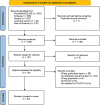Implications for implementation and adoption of telehealth in developing countries: a systematic review of China's practices and experiences
- PMID: 37723237
- PMCID: PMC10507083
- DOI: 10.1038/s41746-023-00908-6
Implications for implementation and adoption of telehealth in developing countries: a systematic review of China's practices and experiences
Abstract
The rapid advancement of telehealth technologies has the potential to revolutionize healthcare delivery, especially in developing countries and resource-limited settings. Telehealth played a vital role during the COVID-19 pandemic, supporting numerous healthcare services. We conducted a systematic review to gain insights into the characteristics, barriers, and successful experiences in implementing telehealth during the COVID-19 pandemic in China, a representative of the developing countries. We also provide insights for other developing countries that face similar challenges to developing and using telehealth during or after the pandemic. This systematic review was conducted through searching five prominent databases including PubMed/MEDLINE, Embase, Scopus, Cochrane Library, and Web of Science. We included studies clearly defining any use of telehealth services in all aspects of health care during the COVID-19 pandemic in China. We mapped the barriers, successful experiences, and recommendations based on the Consolidated Framework for Implementation Research (CFIR). A total of 32 studies met the inclusion criteria. Successfully implementing and adopting telehealth in China during the pandemic necessitates strategic planning across aspects at society level (increasing public awareness and devising appropriate insurance policies), organizational level (training health care professionals, improving workflows, and decentralizing tasks), and technological level (strategic technological infrastructure development and designing inclusive telehealth systems). WeChat, a widely used social networking platform, was the most common platform used for telehealth services. China's practices in addressing the barriers may provide implications and evidence for other developing countries or low-and middle- income countries (LMICs) to implement and adopt telehealth systems.
© 2023. Springer Nature Limited.
Conflict of interest statement
The authors declare no competing interests.
Figures


Similar articles
-
Beyond the black stump: rapid reviews of health research issues affecting regional, rural and remote Australia.Med J Aust. 2020 Dec;213 Suppl 11:S3-S32.e1. doi: 10.5694/mja2.50881. Med J Aust. 2020. PMID: 33314144
-
Telehealth services for global emergencies: implications for COVID-19: a scoping review based on current evidence.BMC Health Serv Res. 2023 Jun 1;23(1):567. doi: 10.1186/s12913-023-09584-4. BMC Health Serv Res. 2023. PMID: 37264401 Free PMC article.
-
Free and Charitable Clinic Perspectives on the Implementation and Utilization of Telehealth Services During the COVID-19 Pandemic.J Prim Care Community Health. 2023 Jan-Dec;14:21501319231213783. doi: 10.1177/21501319231213783. J Prim Care Community Health. 2023. PMID: 38041422 Free PMC article.
-
Telehealth use in the well-child health setting. A systematic review of acceptability and effectiveness for families and practitioners.Int J Nurs Stud Adv. 2024 Dec 3;8:100277. doi: 10.1016/j.ijnsa.2024.100277. eCollection 2025 Jun. Int J Nurs Stud Adv. 2024. PMID: 39734584 Free PMC article.
-
Mental health service users' experiences of telehealth interventions facilitated during the COVID-19 pandemic and their relevance to nursing: An integrative review.J Psychiatr Ment Health Nurs. 2023 Dec;30(6):1114-1129. doi: 10.1111/jpm.12943. Epub 2023 Jun 6. J Psychiatr Ment Health Nurs. 2023. PMID: 37278201 Review.
Cited by
-
Nurse-Delivered Telehealth in Home-Based Palliative Care: Integrative Systematic Review.J Med Internet Res. 2025 May 5;27:e73024. doi: 10.2196/73024. J Med Internet Res. 2025. PMID: 40324776 Free PMC article. Review.
-
Disease burden comparison and associated risk factors of early- and late-onset neonatal sepsis in China and the USA, 1990-2019.Glob Health Action. 2024 Dec 31;17(1):2396734. doi: 10.1080/16549716.2024.2396734. Epub 2024 Sep 4. Glob Health Action. 2024. PMID: 39229931 Free PMC article.
-
A Comprehensive Review on Exploring the Impact of Telemedicine on Healthcare Accessibility.Cureus. 2024 Mar 12;16(3):e55996. doi: 10.7759/cureus.55996. eCollection 2024 Mar. Cureus. 2024. PMID: 38618307 Free PMC article. Review.
-
The Role of AI in Hospitals and Clinics: Transforming Healthcare in the 21st Century.Bioengineering (Basel). 2024 Mar 29;11(4):337. doi: 10.3390/bioengineering11040337. Bioengineering (Basel). 2024. PMID: 38671759 Free PMC article. Review.
-
Multidisciplinary Telemedicine in Healthcare During and After the COVID-19 Pandemic: A Narrative Review.Life (Basel). 2025 May 14;15(5):783. doi: 10.3390/life15050783. Life (Basel). 2025. PMID: 40430210 Free PMC article. Review.
References
-
- World Health Organization, Implementing telemedicine services during COVID-19: guiding principles and considerations for a stepwise approach. (2020).
Publication types
LinkOut - more resources
Full Text Sources
Miscellaneous

